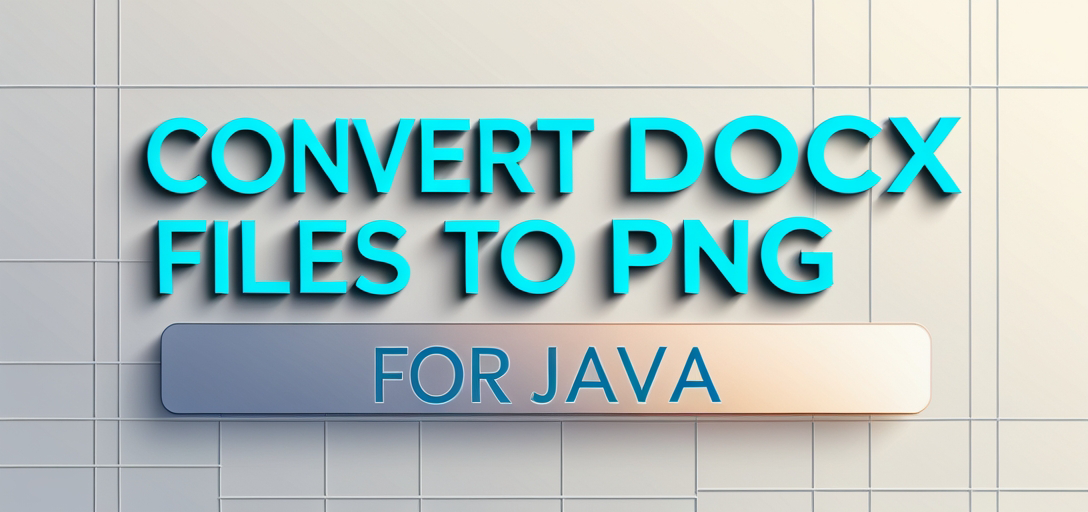How to Convert DOCX Files to PNG Using GroupDocs.Viewer for Java
Introduction
Converting Word documents into image formats like PNG is essential for various purposes such as archiving, sharing without editing capabilities, or creating document thumbnails. This tutorial guides you through using GroupDocs.Viewer for Java to transform your Word documents into high-quality PNG images effortlessly.

What You’ll Learn:
- How to set up and configure GroupDocs.Viewer for Java.
- A step-by-step guide on rendering DOCX files to PNG images.
- Key configuration options for optimal image output.
- Practical applications of this feature in real-world scenarios.
- Tips for troubleshooting common issues during implementation.
Let’s explore the prerequisites needed before we begin transforming your documents!
Prerequisites
Before starting, ensure you have the necessary tools and knowledge:
Required Libraries, Versions, and Dependencies
You’ll need GroupDocs.Viewer library version 25.2 or later. Include it in your Java project using Maven for dependency management.
Environment Setup Requirements
- Ensure JDK (Java 8 or higher) is installed on your system.
- Use an IDE like IntelliJ IDEA or Eclipse to write and execute your Java code.
Knowledge Prerequisites
Familiarity with basic Java programming concepts and experience building projects using Maven will be beneficial. We’ll guide you through each step, even if you’re new to these tools.
Setting Up GroupDocs.Viewer for Java
To use GroupDocs.Viewer, add it as a dependency in your project via Maven:
Maven Configuration
<repositories>
<repository>
<id>repository.groupdocs.com</id>
<name>GroupDocs Repository</name>
<url>https://releases.groupdocs.com/viewer/java/</url>
</repository>
</repositories>
<dependencies>
<dependency>
<groupId>com.groupdocs</groupId>
<artifactId>groupdocs-viewer</artifactId>
<version>25.2</version>
</dependency>
</dependencies>
License Acquisition Steps
To fully utilize GroupDocs.Viewer, consider acquiring a license:
- Free Trial: Download the library from GroupDocs Downloads to test its capabilities.
- Temporary License: Obtain a temporary license for extended evaluation via Temporary License.
- Purchase: For commercial use, purchase a license through GroupDocs Purchase Page.
Once set up, let’s initialize and configure GroupDocs.Viewer.
Basic Initialization
To open a DOCX file for rendering:
import com.groupdocs.viewer.Viewer;
try (Viewer viewer = new Viewer("path/to/SAMPLE_DOCX")) {
// Your code to render the document will go here.
} catch (Exception e) {
e.printStackTrace();
}
This snippet opens a document and prepares it for rendering. Replace "path/to/SAMPLE_DOCX" with your actual file path.
Implementation Guide
Now, let’s break down the steps to render DOCX documents as PNG images.
Rendering Documents to PNG Images
Overview We’ll configure GroupDocs.Viewer to convert each page of a DOCX document into individual PNG files. This is useful for web applications needing document previews or offline viewing capabilities.
Step 1: Setup Output Directory and Options
Specify where you want the images saved:
import java.nio.file.Path;
import java.nio.file.Paths;
// Define output path for rendered PNGs
Path outputDirectory = Paths.get("YOUR_OUTPUT_DIRECTORY");
Path pageFilePathFormat = outputDirectory.resolve("page_{0}.png");
// Create view options to render as PNG
PngViewOptions viewOptions = new PngViewOptions(pageFilePathFormat);
Why It Matters: The pageFilePathFormat ensures each document page is saved with a unique filename in the specified directory.
Step 2: Render Document
Render the DOCX file into PNG images using the configured options:
import com.groupdocs.viewer.Viewer;
import com.groupdocs.viewer.options.PngViewOptions;
try (Viewer viewer = new Viewer("YOUR_DOCUMENT_DIRECTORY/SAMPLE_DOCX")) {
// Convert document pages to PNG format
viewer.view(viewOptions);
} catch (Exception e) {
e.printStackTrace();
}
Why It Matters: The view method processes each page of the document, saving them as PNG images according to your defined output path.
Troubleshooting Tips
- Ensure specified directories exist or handle directory creation in code.
- Verify file paths and permissions if you encounter a
FileNotFoundException. - Check compatibility with different DOCX files for rendering issues.
Practical Applications
Rendering documents to image formats has several real-world applications:
- Document Archiving: Create immutable versions of your documents.
- Web Previews: Display document previews on websites without allowing edits.
- Offline Access: Provide offline access through images in mobile or desktop apps.
- Data Security: Prevent unauthorized edits by sharing only image representations.
GroupDocs.Viewer can integrate with content management systems (CMS) to automate these processes, enhancing productivity and security.
Performance Considerations
Rendering documents efficiently is crucial for maintaining application performance:
Tips for Optimizing Performance
- Use efficient file handling techniques.
- Limit the resolution or size of PNG images based on use case requirements.
Resource Usage Guidelines
- Monitor memory usage during rendering to avoid
OutOfMemoryError. - Dispose of resources properly by using try-with-resources as shown in the code.
Best Practices for Java Memory Management
- Keep your application’s memory footprint minimal by managing large document processing efficiently with GroupDocs.Viewer.
- Profile and tune your JVM settings according to your environment’s needs.
Conclusion
You should now have a solid understanding of how to render DOCX documents as PNG images using GroupDocs.Viewer for Java. This capability not only enhances the way you share and archive documents but also opens up new avenues for document management in web applications.
Next Steps
Explore more advanced features of GroupDocs.Viewer, such as rendering different document formats or integrating with cloud storage solutions.
Ready to get started? Implement this solution today and revolutionize your document handling workflows!
FAQ Section
Q1: Can I render PDFs using GroupDocs.Viewer for Java? A1: Yes, GroupDocs.Viewer supports various file formats including PDF. Refer to the API Reference for details.
Q2: How do I handle large documents efficiently? A2: Consider rendering pages in batches and optimizing memory usage as outlined in the performance considerations section.
Q3: What if my output directory does not exist? A3: Ensure your code checks and creates necessary directories before rendering.
Q4: Is it possible to customize image quality or size? A4: Yes, GroupDocs.Viewer provides options to adjust output settings such as resolution for PNG images.
Q5: Where can I get support if I encounter issues? A5: Visit the GroupDocs Support Forum for assistance from community and experts.
Resources
- Documentation: GroupDocs.Viewer Java Docs
- API Reference: GroupDocs API Reference